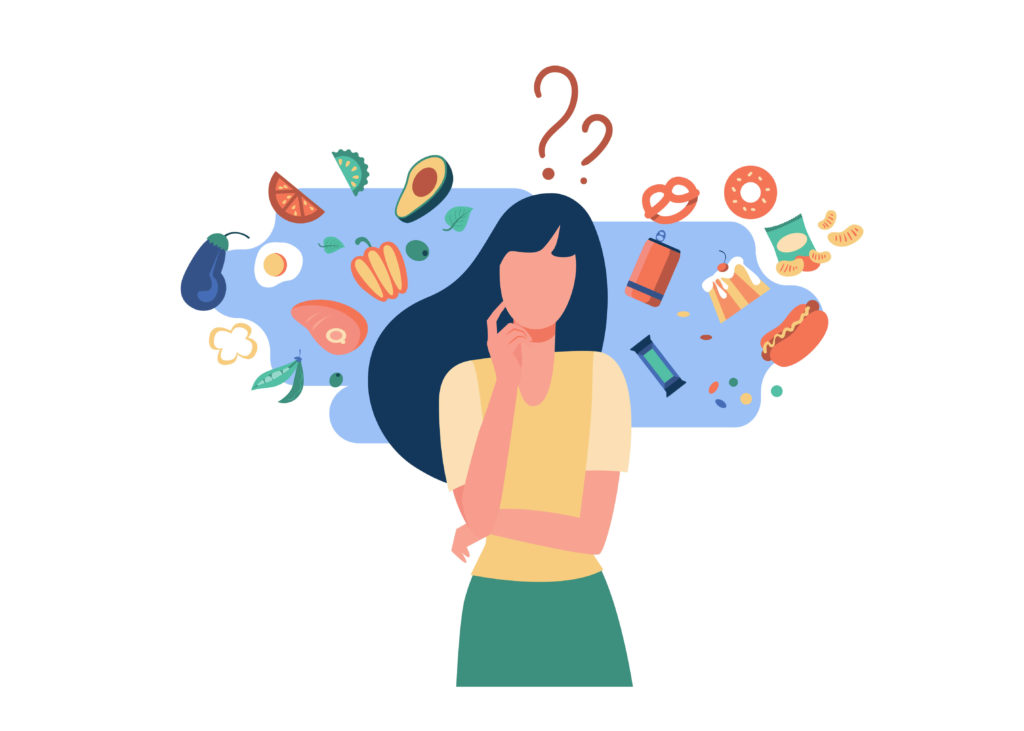

Food cravings are very different to true hunger. When we’re experiencing ‘true hunger’, a wide variety of foods are likely to satisfy us, we are able to eat them slowly and mindfully which results in satisfaction afterwards.
When we’re experiencing craving’s this is referred to as psychological hunger, the craving will be specific towards one kind of food (usually high fat/ sugar/ salt), they come on suddenly, we eat them rapidly and we may not feel satisfied afterwards as a result.. This can lead to the ‘what’s next?’ feeling.
It’s perfectly okay to indulge in cravings every now and then when we eat them mindfully but if we have more tools in our tool box with how to manage them, we are more likely to reach and maintain our health and nutrition goals!
- Replace refined carbohydrates with wholegrain alternatives
Research has shown that if we eat low fibre, refined carbohydrates such as white bread, white rice or sugar, we will crave more of these foods later on. Why? These foods cause our blood sugar levels to spike, then rapidly drop, signaling to our brain that more ‘sugar’ is needed.
Instead of choosing refined carbohydrates and sugars, opt for low GI wholegrains and starchy vegetables that will keep your blood sugar levels stable between meals. For example, heavily seeded breads, oats, quinoa, sweet potato, and lentils.
- Spread your protein intake throughout the day
Foods high in protein are most effective for neutralizing ghrelin, a hormone that stimulates hunger and cravings. Furthermore, protein reduces the speed at which carbohydrates in your meal are absorbed, keeping your blood sugar levels stable for longer. Lastly, a full stomach can help to reduce cravings, and proteins are proven to be the more satisfying than fats and carbohydrates, according to a ‘Satiety Index’ of foods.Most of us succeed at including protein-rich foods at dinner, but in order to reduce cravings during the day, consider your breakfast and lunch options too. Think eggs, Greek yoghurt, cottage cheese and nuts in the morning. At lunchtime, consider adding tuna, chicken, legumes or cheese to your sandwich or salad. Snack on crackers with cheese or tuna, boiled eggs, yoghurt and nuts in the afternoon, before the 4pm ‘sugar-o-clock’ hits.
- The ‘3-hour rule’
This rule is perfect for mid-afternoon cravings. On average, a balanced main meal containing low GI carbohydrates, lean protein and vegetables should keep your blood sugars stable and your tummies full for at least 3 hours. So, remind yourself that you don’t need food during this timeframe! If your next main meal is only 4 hours after, you may not need to snack at all between meals.
- Eat your meals mindfully
If you read the paper, watch TV or work during your main meals (i.e., your focus is not wholly on eating) you are less likely to feel ‘emotionally’ satisfied after eating. And – you may seek that ‘food pleasure’ with a chocolate bar soon after. Try eating slowly and mindfully – consciously enjoying every mouthful – and see whether your cravings disappear! - Prioritise sleep
Cravings can be our body’s way of telling us we lacking in energy, and it may be unrelated to food choices. Lack of sleep, for example, has been shown to increase sugar cravings throughout the day. Researchers from the University of Chicago recently demonstrated that people who had a good night’s sleep ate 400 less calories from snacks in the afternoon. It makes sense; sugar is the fastest form of available energy.Aim for 7-8 hours of quality sleep each night. To help you achieve this, plan to go to bed at a reasonable hour, and start practicing your ‘sleep hygiene’ routine about 60 minutes prior. We recommend switching off all electronics, dimming lights, reducing noise levels, and doing calming activities such as reading a book. Exercising during the day may also help to improve sleep quality
- Create a list of other activities
Many of us ‘crave’ foods as a way of coping with certain emotions, such as boredom, stress, anger or sadness. Often, eating will not properly address these situations; just delay them for a short time. It may even make these feelings worse. Try and ‘call out’ your food cravings for what they really are – a coping strategy – and create a list of alternative coping strategies, such as reading a book, going for a walk, lighting a candle, have a warming shower/ bath, play with a pet, speak with a loved one etc.
